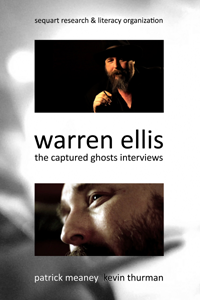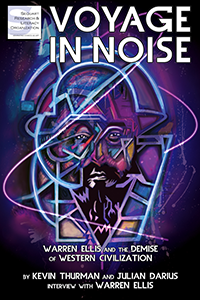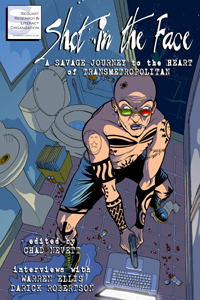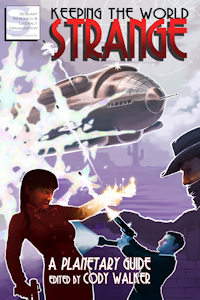The title of this essay comes from lines spoken by the character Jenny Sparks in Warren Ellis’s first issue as writer on the WildStorm title Stormwatch (#37, July 1996), after she is recruited to the titular super-team. Created by Ellis and something of an avatar for him – she is, like Ellis, English and fond of cigarettes and whisky – Jenny’s attitude towards typical superhero costume is representative of Ellis’s own distaste for what he has termed ‘pervert suits’, and her reluctance to join the team because superheroes always target ‘the soldiers not the generals’ is an expression of Ellis’s oft-stated dislike of the superhero genre’s essentially reactionary power dynamics. Despite his contempt for the superhero genre, Ellis nevertheless revitalised it in the mid-late 1990s / early 2000s with his work on the titles The Authority and Planetary for WildStorm. Although not creator-owned books – produced under work-for-hire conditions they are the intellectual property of the publisher – these comics nevertheless contributed greatly to Ellis’s growing status as a comic book auteur, comparable to other British writers active in the American comic book industry such as Alan Moore, Neil Gaiman, and Grant Morrison. Significantly, both titles prominently feature super-powered characters who wear ‘civilian’ and / or military clothing rather than traditional superhero costumes. In 2017, Ellis began a ‘re-imagining’ of the WildStorm Universe (the fictional world shared by the publisher’s range of superhero titles) with the ongoing DC Comics series The Wild Storm (DC having acquired WildStorm in 1999; it was made defunct in 2010), which dispenses with traditional superhero costumes entirely. In this essay, I will discuss how Ellis’s rejection of traditional costume expresses his distaste for the genre but also his ambitions for it, arguing that his use of civilian and military garb is part of an entryist strategy to subvert generic conventions in an attempt to merge elements of superhero comics with aspects of other genres such as crime, tech thriller and, particularly, science fiction. In doing so I will draw on Richard Reynolds’ classic structuralist reading of superhero comics Superheroes: A Modern Mythology (1992) and Geoff Klock’s analysis of Ellis’s WildStorm work in How To Read Superhero Comics and Why (2002), as well as my own previous work in this area.
Born in Essex in 1968, Ellis was an avid reader of comics as a child, particularly of the British science fiction anthology 2000AD launched in 1977 (Meaney, 2011). Created by editor and writer Pat Mills, 2000AD was strongly informed by his anti-establishment views and the similar attitude of the UK’s emerging punk subculture (Mills, 2011). 2000AD did not feature superhero stories – the dominant genre in the American comic book industry then as now – in the seventies (and would not do so until the publication of the series Zenith in 1987 and even then the series subverted and critiqued the superhero genre, its creators, writer Grant Morrison and artist Steve Yeowell, having also been strongly influenced by punk). Instead, the comic’s focus on science fiction appealed to Ellis’s nascent futurism (as Ennis’s friend the Northern Irish comic writer Garth Ennis puts it in Patrick Meaney’s documentary about Ellis Captured Ghosts [2011], Ellis ‘likes the future’; in the film Ellis claims that as a young child his favourite part of going to the cinema was watching the previews because they provided ‘little leaks of the future’). Ellis would later be influenced by another British anthology comic, Warrior, created by Dez Skinn in 1982, which did feature superheroes stories, most notably Marvelman (March 1982- August 1984), written by Alan Moore. Ellis has identified Marvelman as being, along with Frank Miller’s run Marvel comic’s superhero title Daredevil (May 1979 – February 1983), instrumental in the ‘birth’ of a ‘third movement’ in superhero comics which would last until 1997 (2000:11) following the Golden and Silver Ages (c1938-1945 and c1955-1978, respectively). Comics produced in this period, including Marvelman, involved a ‘darkening’ of the superhero genre with an increase in violence including the taking of life, something superheroes traditionally never did, and a focus on politics and power relations. Notable works from this period include Miller’s Batman mini-series The Dark Knight Returns (February-June, 1986) and Watchmen (September 1986-October 1987), a 12-issue limited series by Moore and artist Dave Gibbons. As I will demonstrate, Moore’s influence is particularly evident in Ellis’s work throughout the ‘90s.
After contributing horror and science fiction stories to the British comic market, Ellis’s own entry into the superhero genre began in 1994 with DC’s main rival Marvel Comics, for which he wrote a number of titles including Excalibur (November 1994-November 1996), a UK based spin-off from the publisher’s most popular title The X-Men (September 1963). Ellis created the character Pete Wisdom for the series, another avatar who, like Jenny Sparks, is English and enjoys smoking and drinking. Wisdom also has a rather caustic sense of humour – much like that of Ellis’s online persona, as demonstrated on his popular website the Warren Ellis Forum (May 1998-October 2002) – which he frequently directs at the other members of the series’ titular ‘super-team,’ whom he finds somewhat ridiculous, particularly because of their outfits. Significantly Wisdom, despite having super-powers, does not wear a traditional superhero costume, opting for a suit and tie instead. To a large extent, Wisdom recalls another English character created by a British writer for an American superhero publisher: Alan Moore’s John Constantine. Co-created with artists Steve Bissette and John Totleben, Constantine first appeared in issue 25 of DC’s The Saga of the Swamp Thing (June 1984) and shares Wisdom’s dress sense, fondness for alcohol and cigarettes and cynical disposition towards superheroes. Ellis would subsequently go on to write the series featuring Constantine, Hellblazer (February-December 1999). Although initially part of the DC Universe, Hellblazer’s writers gradually toned down its relationship to the rest of the publisher’s superhero comics with appearances from super-heroes becoming increasingly rare as the series developed. There are none at all during Ellis’s run on the title, which focuses instead on Constantine as a type of ‘occult detective’ based in London. The city features prominently in Ellis’s first story-arc for Hellblazer, ‘Haunted’ (#134-139, February-July 1999) which recalls the London-based Factory novels by the British crime writer Derek Raymond, for whom Ellis has expressed admiration in the past, which are characterised by a strong sense of place and attention to London’s geography, Raymond having worked as a mini-cab driver there. Ellis even created a character called Map who works on the London Underground for ‘Haunted’. Ellis would go on to create his own variation on Constantine; the ‘combat magician’ William Gravel for the independent publisher Avatar Press in 1999.
Ellis’s most significant superhero work of the ’90s was published not by Marvel or DC but instead by WildStorm, an imprint of Image Comics, an independent publisher formed in 1992 by a group of young Marvel employees, disgruntled by the work-for-hire conditions at the publisher and keen to develop their own intellectual property rather than service corporate trademarks. Phenomenally successful during the comics ‘boom’ of the early ‘90s, Image titles frequently outsold comics from both Marvel and DC, hitherto the market leaders for superhero comic books. However, Image was derided by both critics and established industry figures for being vulgar, adolescent, and excessively violent (Jones and Jacobs, 343-351). Mark Waid, a veteran writer for both Marvel and DC, used the situation as the basis for his mini-series Kingdom Come (May-August 1996), described by Gerard Jones and Will Jacobs as ‘a story by a fan, for fans, about the state of the superhero business’ (365) in which young, upstart superhumans, modeled after the Image characters, square off against elderly versions of DC’s pantheon of heroes depicted by the series’s artist Alex Ross as ‘ancient, august and not at all pleased’ (366). Unlike their elders, the young superhumans in Kingdom Come, even those who are supposed to be heroes, are prepared to kill as was also the case with the Image characters they were based upon, including those whom Ellis would both inherit and create for the publisher. Ellis took over the super-team title Stormwatch, created by the imprint’s owner Jim Lee in 1993, with issue 37 (July 1996), in which he introduced his latest avatar Jenny Sparks. As mentioned above, one of the conditions for Sparks joining the team is that she will not be expected to wear a traditional superhero costume. The lines from the character which give this essay its title refer to the sartorial and anatomical conventions introduced by Lee and the other founders of Image during their time at Marvel. Jones and Jacobs describe Lee’s style as being characterised by ‘massiveness and forward thrusts’, ‘exploding muscles’ and ‘plastic breasts’ (325). Female characters in particular where objectified:
His most distinctive invention was the Lee woman: elongated legs, plastic flesh, wasp waist, moulded breasts, an icon of consumer-culture sexual symbols without a trace of sex, the Sports Illustrated swimsuit girl as action figure, collectible, superhero trophy. (324)
By contrast Sparks, the ‘spirit of the Twentieth Century’ who has a lifespan of 100 years but who stopped ageing at 20, was petite and slightly built and tended to wear a white pant suit, shirt and tie. Sparks’s name recalls an earlier British superhero character, Ruby Fox, created by Morrison and Yeowell for Zenith (1987-1992): the similarity is not confined to the character’s names; like Sparks, Fox, aka Voltage, is English and is able to control electricity. Sparks appears on the cover of Stormwatch #37, albeit in the background, beside another character Ellis created for the title Jack Hawksmoor, who also wears a suit and tie. Hawksmoor is featured prominently on the cover of the next two issues and is the ‘cover star’ of #43 (December, 1996) as is Sparks for #47 (May, 1997). Title aside, there is nothing on the cover of either of these issues to indicate they are superhero comics. The same is true of #45 (February, 1997), the deliberately provocative cover of which shows the African-American superhero Jackson King aka Battalion out of costume and in manacles. The story deals with institutionalised racism in the American South from which not even a super-powered black man is safe. Apart from King’s ‘explosive muscles’ the cover image offers no suggestion he is a superhero.
Issue 43 is the beginning of the final story-arc for volume 1 of Stormwatch, ‘Change or Die’, the title of which can be read as an expression of Ellis’s attitude towards the superhero genre and a statement of intent for its future. By this point, superhero comics had become rather stagnant and overly ‘grim and gritty’, with only a few exceptions, such as Waid’s run on DC’s The Flash (Vol. 2, ##62-162, May 1992-July 2000), its spin-off title Impulse (##1-27, April 1995-July 1997), and Morrison’s JLA (January 1997-May 2000) also for DC. These comics looked back to the vibrancy and dynamism of the ‘Silver Age’ superhero comics of the fifties and sixties rather than the aggression and angst which Watchmen and The Dark Knight Returns had unintentionally made pervasive in the genre, and which, in simplified form, had become Image’s stock-in-trade. Lee himself was already aware of the moribund state of superhero comics, including his own, hiring Moore to write Stormwatch‘s much more successful, if equally unsophisticated, ‘sister’ title WildC.A.T.S from issue 21 (July, 1995). As he had with the intellectual property of both DC and Marvel in the 1980s, Moore, who had severed ties with both of those publishers in the ’80s over creator’s rights disputes, brought considerable depth and nuance to Lee’s initial concept of a hidden battle between two alien races stranded on Earth. Ellis would do the same with Stormwatch, particularly in the second volume of the series in which he allocated Sparks and Hawksmoor, along with the Lee-created character Swift, to a splinter team labelled Stormwatch Black, the remit of which was to focus on undercover operations rather than public superheroics. Ellis introduced a prominent element of political commentary to the series alongside elements of government conspiracy similar to those found in the, at the time, phenomenally successful television series The X-Files (1993-2016); indeed on the cover of volume 2 #2, which deals with unlawful activities by the US military, a common theme in The X-Files, Sparks strongly resembles the series’ character Dana Scully (Gillian Anderson). In fact, it is only the presence of the winged Swift on the cover (which features all three members of Stormwatch Black uncovering containers of hazardous material marked with a skull and crossbones symbol and an American flag) that indicates that it is a superhero comic.
As Richard Reynolds has observed ‘[c]ostume functions as the crucial sign of super-heroism’. ‘The appearance of a costumed character in a story,’ he writes
will generate a specific set of expectations – a state of affairs which the writer and artist can work with or against, but which cannot wholly be left out of account. (26)
Swift is the only character in the issue to wear anything approaching a superhero costume, and even then her outfit is closer to the Lycra sportswear popular at the time than the spandex apparel typical of ‘90s superheroes. The members of Stormwatch who do participate in public displays of super-heroism are shown in civilian clothing, as the issue’s B-plot involves them drinking heavily in the WildStorm Universe’s super-hero pub Clark’s Bar, created by Moore for WildC.A.T.S, the name and logo of which are references to DC’s Superman and his ‘secret identity’ Clark Kent. Ellis had used a similar plotline in Excalibur #91 (November, 1995) and indeed a character from that title, Nightcrawler, can be seen in the background of the bar scenes alongside other prominent Marvel characters, many of whom are out of costume. In both Excalibur and Stormwatch, Ellis attempts to humanise his characters by depicting their off-duty activities, including their love lives and sexual activities, while still taking into account their powers and abilities. In #2, the ‘gaseous posthuman entity’ and Stormwatch member Toshiro Misawa (aka Fuji), for example, informs his teammates that the extreme sensitivity of his form to vibrations means he orgasms every five minutes. This prompts another member, Flint, to respond ‘if a bad guy was to just jump up and down a lot, Toshiro would be crippled in minutes’, recalling the sardonic realism of both Watchmen and Zenith.
The visual style of Stormwatch volume 2 changed noticeably with the introduction of art team Bryan Hitch (pencils) and Paul Neary (inks), from the fourth issue (February 1998). A veteran of the British comics industry, Hitch’s artwork was heavily influenced by the style of Alan Davis, a frequent collaborator with Moore, including on Marvelman. Davis’s realistic pencilling had been the perfect complement to the Moore’s radical approach to Marvelman, which was to apply ‘real life logic to a superhero’ (Khoury: 12). Similarly, the anatomy of Hitch’s characters was more realistic than the Image style, which had come to dominate the genre. Hitch and Neary’s first story-arc ‘A Finer World’ introduced the characters Apollo and the Midnighter, analogues of Superman and Batman respectively. Apollo’s costume, a white and gold body stocking, is consistent with the bright costuming associated with Superman and other imitations of the character such as Fawcett Comics’ Captain Marvel or WildStorm’s own Mr Majestic. The Midnighter’s costume shares the same dark colour scheme as Batman’s, particularly the iterations of him in and after Miller’s The Dark Knight Returns. Miller’s vision of Batman informed the representation of the character in Christopher Nolan’s Batman films, known as ‘The Dark Knight Trilogy’ – Batman Begins (2005); The Dark Knight Returns (2008); The Dark Knight Rises (2012) – which, as with Moore in Marvelman, strived for realism, including in costume. Instead of a traditional cape – which as Moore and Gibbons point out in Watchmen is impractical for crime-fighting – the Midnighter wears a leather trench coat, and sports a rubber fetish mask similar to that worn by the Comedian in Watchmen, rather than the cowl typical of Batman and associated characters such as Batgirl and Batwoman or analogues like Marvel’s Nighthawk. The Midnighter’s footwear is a pair of combat boots similar to those worn by Miller’s Batman in The Dark Knight Returns and Nolan’s screen version, which were a departure from the slip-on boots of superhero tradition and anticipated the military-influenced costumes typical of Image characters. Such boots are commercially available for ‘civilian’ consumers as, indeed, is the rest of the Midnighter’s costume. (It is worth mentioning here too that when DC attempted to modernise Batgirl in 2014, her familiar yellow slip-ons were replaced by Doctor Marten boots in the same colour.)
Ellis uses the ‘A Finer World’ story-arc to further explore the theme of power, and its abuses, central to much of his superhero work. Apollo and the Midnighter’s powers are the result of genetic experimentation carried out on them by the former head of Stormwatch, Henry Bendix, from whom they escaped to become vigilantes as part of the ‘superhuman underground’. The images in the story-arc of the two characters living rough are in sharp contrast to the high-tech lairs of Superman’s Fortress of Solitude or the Batcave. Initially mistaken for criminals by Stormwatch, the duo eventually become their allies but do not join the team, although they would return for Ellis’s next (and most significant, in terms of both his oeuvre and his career) superhero project, The Authority, which I discuss further below. In Captured Ghosts, Ellis claims that WildStorm continued to publish Stormwatch despite low sales because Lee and the imprint’s editors enjoyed reading it. A decision was made, however, to cancel the title with volume 2 then launch a new WildStorm Universe comic featuring certain characters from Stormwatch. This involved Ellis ‘killing off’ the majority of the super-team in the crossover comic WildC.A.T.s / Aliens (August 1998), published jointly by WildStorm and Dark Horse, owners of the rights to publish comics based on the Alien film franchise. Stormwatch Black survived this purge and were used, along with Apollo and the Midnighter, to form a new super-team, the Authority, which also included two original Ellis creations the Doctor and the Engineer. The Authority’s eponymous series was launched in May 1999, with artwork by Hitch and Neary. The wrap-round cover of the first issue shows the team in dynamic poses typical of super-teams, all reaching skyward with the flight-capable Swift and Apollo airborne and the Midnighter prominent in the foreground, teeth and fists clenched. The Engineer is also prominent and is the only character to be at all sexualised. Instead of clothing, the Engineer’s ‘costume’ consists of liquid metal, which completely covers her naked body, although her nipples are smoothed over. While she does have the large breasts typical of the ‘Lee Woman’ and of Image’s female characters generally, the Engineer’s anatomy is more realistic, her face and body recalling the curvaceous actor and pop singer Jennifer Lopez whose star was in the ascendant at the time, and her metallised skin invoking the gynoid Maria from Fritz Lang’s Metropolis (1927) rather than the ‘plastic flesh’ typical of Image. Hitch’s rendition of Sparks resembles the English model and nineties icon Kate Moss, although without any suggestion of either the anorexia or drug addiction of which Moss, associated with the ‘waif look’ and ‘heroin chic’ fashion trends, was regularly accused, particularly at the start of her career. Retaining her white suit from Stormwatch Sparks often pairs it in The Authority with a Union Jack t-shirt, asserting her Englishness and perhaps also alluding to the UK’s Brit-Pop movement which appropriated the flag – Noel Gallagher of rock band Oasis, for example, played a Union Jack guitar on-stage while Geri Halliwell of pop group The Spice Girls wore a mini-dress emblazoned with it – and with which Moss was associated, although by 1999 the movement was essentially over (Morrison proclaimed it to be ‘dead’ on the cover of issue 16 of the second volume of his series for DC’s ‘mature readers’ series The Invisibles [June 1999]). Sparks also regularly sports combat trousers and a flight jacket, referencing her military past as a colonel in the ‘British Space Group’ first revealed in Stormwatch #44 (January 1997) and developed in The Authority‘s second story-arc ‘Shiftships’ (#4-7, September-December, 1999). Hawksmoor also keeps his suit, but is also often shown in a plain white t-shirt. The other new character, the Doctor, a powerful mystic, has an unusual costume for either a superhero or a ‘civilian’, consisting of purple tunic over a high-necked sweater, black britches, yellow boots, red-lensed glasses and a utility belt with large pouches. This outfit does not fit in with the ‘structure of costume conventions’ which Reynolds calls, after Saussure, the langue of superhero costume, with each individual costume ‘an example of parole […] a specific utterance within this language of signs’ (26). Nor does it associate him directly with similarly magical characters such as Marvel’s Doctor Strange, although there are some similarities in colour scheme, or John Constantine to whom he is the sartorial polar opposite. Ellis continued to deviate from the conventions of superhero costume in The Authority‘s ‘sister’ title, Planetary, also launched in 1999, which I will discuss in further detail in Part 2 of this essay.



























































